Petrified Foot —

Bob (aka
Cranky Media Guy) sent me a link to an article about
"Scientific Hoaxes" scanned from the Dec. 1931 issue of
Modern Mechanix magazine. I love old popular-science magazines like this. They're a great source of strange information.
Unfortunately whoever scanned this article missed two pages, so you skip from a discussion of the
Central Park Zoo Escape straight into a discussion of the
Cardiff Giant. Nevertheless, the image of a "petrified foot" on the front page caught my curiosity. The caption reads: "A water-worn stone was once offered to the Smithsonian Institute as a petrified foot. Note the striking resemblance."
The article offers no more information about this unusual gift to the Smithsonian. So I did some research in the Google News Archive and was able to find a reference to the petrified foot in a July 18, 1908
Washington Post article titled "Nature as a Faker":
To the Smithsonian Institution not long ago somebody sent from the Bad Lands of Nebraska what purported to be a fossil ham. It did in very truth look like a ham, and, to render the verisimilitude complete, the bone was actually sticking out at one end of it. Nevertheless, an investigation showed that the alleged bone was in reality a "vaculite" -- an extinct mollusk's shell, rodlike in form -- and the rest of the "ham" was a mere accidental agglomeration of stony stuff.
One day, quite recently, a young man walked into the National Museum at Washington and presented to the anthropologist in charge a petrified foot. It was received with many thanks, though recognized at a glance as a water-worn fragment of rock which had accidentally assumed a shape resembling a foot.
Such chance imitations as these frequently occur in nature. Another one, deposited in the same institution, was supposed by the finder to be a petrified oyster. It looks as if on the half shell: all its parts are wonderfully distinct, and there is even a small pearl in it seemingly. Yet it is not an oyster at all.
Nineteenth-century newspapers were full of reports of animals and body parts found petrified in their entirety, perfectly preserved, which reflected a popular misunderstanding about the process of petrifaction. Soft tissue is almost never petrified, because it decays long before the petrifaction process can occur.

 Here's another "Jesus Image in a Tree" for my collection. This one was found by Pennsylvania resident Craig O'Connor. MyFoxColorado.com reports:
Here's another "Jesus Image in a Tree" for my collection. This one was found by Pennsylvania resident Craig O'Connor. MyFoxColorado.com reports:
 Bob (aka Cranky Media Guy) sent me a link to an article about "Scientific Hoaxes" scanned from the Dec. 1931 issue of Modern Mechanix magazine. I love old popular-science magazines like this. They're a great source of strange information.
Bob (aka Cranky Media Guy) sent me a link to an article about "Scientific Hoaxes" scanned from the Dec. 1931 issue of Modern Mechanix magazine. I love old popular-science magazines like this. They're a great source of strange information.

 Renee Brewster of Florida found Jesus while preparing potato salad. His image was clearly visible in the moldy rot that had formed in the center of the first potato she split open. She put aside the holy potato and finished making the potato salad, which reportedly tasted excellent.
Renee Brewster of Florida found Jesus while preparing potato salad. His image was clearly visible in the moldy rot that had formed in the center of the first potato she split open. She put aside the holy potato and finished making the potato salad, which reportedly tasted excellent. If one Jesus-in-a-potato isn't enough for you, then you're in luck, because the MyFoxOrlando article links to a second story, from just a few weeks ago, about a Houston woman who also discovered Jesus inside a potato. But I think the Florida Jesus-Potato is better.
If one Jesus-in-a-potato isn't enough for you, then you're in luck, because the MyFoxOrlando article links to a second story, from just a few weeks ago, about a Houston woman who also discovered Jesus inside a potato. But I think the Florida Jesus-Potato is better. Flora posted an image in the forum of what looks like a Martian bigfoot. (I inserted a picture of the Patterson-Gimlin Bigfoot for comparison.)
Flora posted an image in the forum of what looks like a Martian bigfoot. (I inserted a picture of the Patterson-Gimlin Bigfoot for comparison.)

 A New Mexico family reports that an image of the Virgin Mary has appeared in the pattern of the texture of their wall. Their granddaughter says, "I think God is trying to tell us something, like a message from heaven." Maybe that message is, "Don't get a job applying wall texture."
A New Mexico family reports that an image of the Virgin Mary has appeared in the pattern of the texture of their wall. Their granddaughter says, "I think God is trying to tell us something, like a message from heaven." Maybe that message is, "Don't get a job applying wall texture." A Florida man who recently had a chest X-ray says that he can see Jesus in it. Which raises the question, just what HAS that guy been smoking?
A Florida man who recently had a chest X-ray says that he can see Jesus in it. Which raises the question, just what HAS that guy been smoking? We've got a pareidolia double feature. First up is an image of the Virgin Mary that some claim to see in a sycamore tree that was burned in the recent Southern California fires. The tree is located off the Sierra Highway in Los Angeles County. KNBC reports:
We've got a pareidolia double feature. First up is an image of the Virgin Mary that some claim to see in a sycamore tree that was burned in the recent Southern California fires. The tree is located off the Sierra Highway in Los Angeles County. KNBC reports: Second up is a Jesus and Mary Pancake (which sounds kind of like a rock group) which Marilyn Smith recently sold on eBay for $338. In her description of the item, Smith writes:
Second up is a Jesus and Mary Pancake (which sounds kind of like a rock group) which Marilyn Smith recently sold on eBay for $338. In her description of the item, Smith writes:
 From Cranky Media Guy, with the comment, "New horizons in pareidolia":
From Cranky Media Guy, with the comment, "New horizons in pareidolia": A conker tree in Holdenhurst, Dorset was cut down. Inside one of the branches was found an image of a tiny tree. Tree experts say that the brown mark is caused by disease -- that the heart of the wood was beginning to rot. Personally, I don't think the mark looks like a tree. I think it looks like Jesus (wearing a tree costume). Link: The Daily Mail.
A conker tree in Holdenhurst, Dorset was cut down. Inside one of the branches was found an image of a tiny tree. Tree experts say that the brown mark is caused by disease -- that the heart of the wood was beginning to rot. Personally, I don't think the mark looks like a tree. I think it looks like Jesus (wearing a tree costume). Link: The Daily Mail.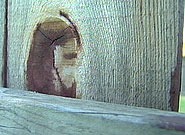 Lodi, California: Emily West was doing some meditating over the weekend in her sister's backyard in central Lodi when something caught her eye. "I looked up and saw the face of Christ in the fence and I said, "Whoa," West said. She called her sister Ana over to ask what she saw. She too agreed, it was the Son of God.
Lodi, California: Emily West was doing some meditating over the weekend in her sister's backyard in central Lodi when something caught her eye. "I looked up and saw the face of Christ in the fence and I said, "Whoa," West said. She called her sister Ana over to ask what she saw. She too agreed, it was the Son of God.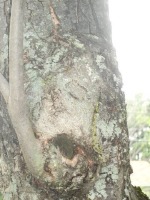
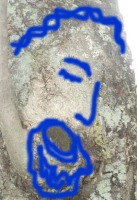
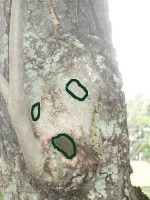
 A Texas woman thinks a pattern in the trunk of a tree in the parking lot of her local supermarket looks like a pair of angel wings. And, for good measure, she also thinks she might see Jesus there too. The woman, Gayle Griffin, says:
A Texas woman thinks a pattern in the trunk of a tree in the parking lot of her local supermarket looks like a pair of angel wings. And, for good measure, she also thinks she might see Jesus there too. The woman, Gayle Griffin, says: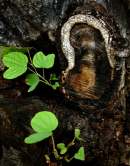 Here's yet another image of Jesus on a tree to add to my collection.
Here's yet another image of Jesus on a tree to add to my collection.  Memphis church-goers claim that the face of God has appeared in the ceiling of their church. The story of the image's first appearance is quite dramatic:
Memphis church-goers claim that the face of God has appeared in the ceiling of their church. The story of the image's first appearance is quite dramatic:  Donald Stephens, Mayor of Rosemont in Illinois for fifty-one years, died on April 18. But now he's come back. On a tree. The Chicago Tribune reports that:
Donald Stephens, Mayor of Rosemont in Illinois for fifty-one years, died on April 18. But now he's come back. On a tree. The Chicago Tribune reports that: 
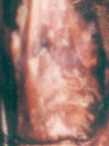 Jon-Erik Beckjord has taken photographs that show images of Ron Goldman and Nicole Brown Simpson, as well as OJ Simpson, he claims. The photos were taken at the scene of the murders, and Beckjord believes that the images are an accusation from beyond the grave. He says that the photographs show OJ's face alongside those he was acquitted of murdering, and his theory is that the spirits of Goldman and Simpson are making a statement.
Jon-Erik Beckjord has taken photographs that show images of Ron Goldman and Nicole Brown Simpson, as well as OJ Simpson, he claims. The photos were taken at the scene of the murders, and Beckjord believes that the images are an accusation from beyond the grave. He says that the photographs show OJ's face alongside those he was acquitted of murdering, and his theory is that the spirits of Goldman and Simpson are making a statement.